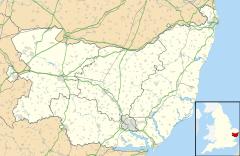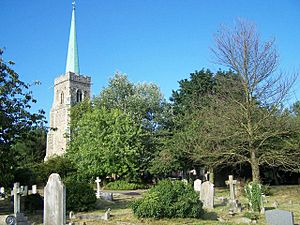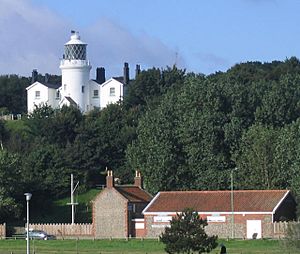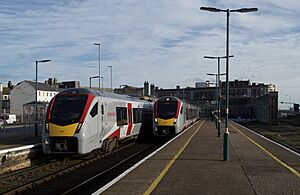Lowestoft facts for kids
Quick facts for kids Lowestoft |
|
|---|---|
| Town and civil parish | |
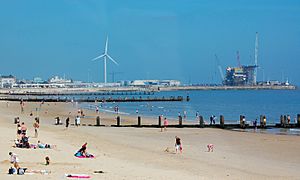 Lowestoft beach and outer harbour |
|
| Area | 21.43 km2 (8.27 sq mi) |
| Population | 71,327 (2021 census) |
| • Density | 3,328/km2 (8,620/sq mi) |
| OS grid reference | TM548933 |
| • London | 110 mi (180 km) south-west |
| Civil parish |
|
| District |
|
| Shire county | |
| Region | |
| Country | England |
| Sovereign state | United Kingdom |
| Post town | Lowestoft |
| Postcode district | NR32, NR33 |
| Dialling code | 01502 |
| Police | Suffolk |
| Fire | Suffolk |
| Ambulance | East of England |
| EU Parliament | East of England |
| UK Parliament |
|
Lowestoft is a coastal town in Suffolk, England. It is the most easterly place in the United Kingdom. Lowestoft is about 38 miles (61 km) north-east of Ipswich. It is also 22 miles (35 km) south-east of Norwich.
The town grew because of its fishing industry. It also became a popular seaside resort with wide sandy beaches. When fishing became less important, the town focused on oil and gas work in the North Sea. In 2021, the town area had a population of 71,327 people.
Contents
History of Lowestoft
Some of the oldest signs of people living in Britain have been found here. In 2005, flint tools were found in the Pakefield cliffs. These tools show that humans lived in this area 700,000 years ago.
People lived here during the Neolithic (New Stone Age), Bronze Age, and Iron Age. They also lived here in Roman and Saxon times. Many interesting items have been found at a Saxon cemetery called Bloodmoor Hill. The name Lowestoft comes from a Norse name, Hlothver, and toft, an old Norse word for a home.
In the Middle Ages, Lowestoft became an important fishing town. It even competed with its neighbour, Great Yarmouth. Fishing, especially for herring, was the town's main activity until the 20th century.
The naval Battle of Lowestoft happened in June 1665. It was the first battle in the Second Anglo-Dutch War. The English won this battle, which took place about 40 miles (64 km) off the coast.
The Lowestoft Porcelain Factory made pottery from 1757 to 1802. It was one of the longest-running porcelain makers in England. They made pots, teapots, and jugs for homes.
In the 1800s, Sir Samuel Morton Peto helped Lowestoft a lot. He built a railway line for the Lowestoft Railway and Harbour Company. This line connected Lowestoft to Reedham and Norwich. The railway helped the town's industries grow. Fishing boats could sell their catches further inland. Other businesses, like engineering, also benefited. Peto's railway also helped Lowestoft become a popular seaside resort. Many of his buildings, like the Kirkley Cliff terraces, are still standing.
During World War I, the German Navy attacked Lowestoft on April 24, 1916. The town's port was a major naval base during the war. In World War II, the German air force (Luftwaffe) bombed the town heavily. This was because of its factories and naval base. Lowestoft was one of the most bombed towns in the UK for its size. The Royal Naval Patrol Service was based here. Its depot was known as HMS Europa or the Sparrow's Nest.
How Lowestoft is Run
Lowestoft is the main town in the East Suffolk area. In 1885, Lowestoft became a municipal borough. This meant it had its own local government. In 1974, it became part of the Waveney area.
Since 2017, Lowestoft has its own civil parish. It is run by the Lowestoft Town Council. The council elects a town mayor each year. Suffolk County Council is the larger authority for the whole county.
The town is also part of the Lowestoft parliamentary area. This means it elects a Member of Parliament to the UK Parliament. In 2019, the Waveney and Suffolk Coastal councils joined to form the new East Suffolk Council.
Geography and Climate
| Weather chart for Lowestoft | |||||||||||||||||||||||||||||||||||||||||||||||
|---|---|---|---|---|---|---|---|---|---|---|---|---|---|---|---|---|---|---|---|---|---|---|---|---|---|---|---|---|---|---|---|---|---|---|---|---|---|---|---|---|---|---|---|---|---|---|---|
| J | F | M | A | M | J | J | A | S | O | N | D | ||||||||||||||||||||||||||||||||||||
|
51
7
2
|
35
7
2
|
40
9
3
|
42
11
5
|
40
14
8
|
47
18
11
|
44
20
13
|
51
21
13
|
53
18
11
|
58
14
8
|
61
10
5
|
55
8
3
|
||||||||||||||||||||||||||||||||||||
| temperatures in °C precipitation totals in mm source: Met Office |
|||||||||||||||||||||||||||||||||||||||||||||||
|
Imperial conversion
|
|||||||||||||||||||||||||||||||||||||||||||||||
Lowestoft is the easternmost town in the UK. It is located on the North Sea coast. The town is split by Lake Lothing. This lake forms part of Lowestoft Harbour. It connects to Oulton Broad and the River Waveney. This river leads to the Broads, a network of rivers and lakes.
Most of Lowestoft is low-lying. There are some hilly areas in the north. The highest points are about 20–30 metres (66–98 ft) above sea level. The sandy beaches south of the harbour have a Blue Flag status. This means they are very clean and safe. To the north, there are old sand dunes and Ness Point. Ness Point is the easternmost spot in the UK.
Lowestoft has had floods in the past. A big flood happened in January 1953. Another severe flood occurred in December 2013 due to a storm surge.
Lowestoft is one of the driest places in the UK. It gets less than 600 mm (24 inches) of rain each year. Summer temperatures reach about 21 °C (70 °F) in August. Winters are mild, with temperatures around 2 °C (36 °F). Heavy snow is rare.
Economy and Jobs
Lowestoft's economy used to rely on fishing and engineering. Over the years, these industries have become smaller. Now, tourism is growing. The biggest employers are shops and retail businesses. Health, social care, and education also provide many jobs. About 10% of people work in manufacturing.
Jobs can change with the seasons because tourism is important. In 2011, about 10% of working people in the town were looking for jobs.
Traditional Industries

Until the 1960s, fishing was Lowestoft's main industry. Fishing boats caught fish like herring, cod, and plaice. Catches have gone down a lot since then. Now, only a few small boats operate from Lowestoft. The town's fish market is much smaller.
The Centre for Environment, Fisheries and Aquaculture Science (CEFAS) is still in Lowestoft. It is a large research center for fisheries. Other old industries included shipbuilding companies like Brooke Marine. These companies employed many people but closed in the 1990s. Some shipbuilding and repair work still happens at the harbour.
Modern Economy
Today, major employers include Birds Eye frozen foods, with 700 workers. The Sanyo factory closed in 2009. The timber company Jeld-Wen also closed its factory in 2010.
From the 1960s to the 1990s, the oil and gas industry provided many jobs. The Shell base was once the town's biggest employer. It closed in 2003. Oil and gas are still important industries in the area.
Lowestoft is becoming a center for renewable energy. The Orbis Energy centre helps attract green-energy businesses. The Port of Lowestoft is becoming a base for the 500 MW Greater Gabbard wind farm. This will be one of the world's largest offshore wind farms. Other companies are developing tidal energy and wave power systems.
Hoseasons, a company that specializes in UK holidays, also provides many jobs.
Shopping and Tourism
The town center is the main shopping area. There are also several retail parks. Lowestoft is a traditional seaside resort. It started as a bathing spot in the 1760s. The coast is known as the "Sunrise Coast".
The main beaches are south of the harbour. There are two piers, the Claremont and South piers. These piers offer fun things for tourists to do. The beach south of the Claremont Pier is a Blue Flag beach. Lifeguards work there in the summer. Water sports are also popular.
The town has two big attractions. Pleasurewood Hills Theme Park is just north of the town. Africa Alive! wildlife park is in the south, near Kessingland. There is also a holiday park run by Pontins in Pakefield. The Broads and the River Waveney also attract visitors. You can take boat trips and do water sports there.
From 1996 to 2012, Lowestoft hosted a big air show. It featured planes like the Red Arrows and a Lancaster bomber. The air show stopped due to money problems and bad weather.
The Lowestoft Maritime Museum is open from April to October. It shows items about the town's sea history. This includes ship models, art, and fishing tools.
Culture and Community
Lowestoft has three theatres: the Marina, the Players (Lowestoft), and The Seagull. The Marina Theatre has 800 seats. It was updated in 2012. The Royal Philharmonic Orchestra plays there often.
The Lowestoft Museum has a collection of Lowestoft Porcelain. It also shows items about the town's history. There are small museums in Sparrow's Nest Park. These include the Lowestoft War Memorial Museum and the Royal Naval Patrol Service Museum. You can visit the Mincarlo at Lowestoft Harbour. It is the last surviving fishing trawler from Lowestoft. The East Anglia Transport Museum has old buses, trams, and trolleybuses.
Lowestoft has many narrow lanes with steps. Locals call them "scores." Fishermen and smugglers used them long ago. Now, they are part of an annual charity race. The main church, St Margaret, is a very old and important building. Our Lady Star of the Sea Church, Lowestoft is the most easterly Catholic church in the British Isles.
Lowestoft's library has a local history section. Lowestoft Hospital closed in 2016. Services are now at the James Paget University Hospital in Gorleston. The town is twinned with Plaisir, a town in France.
Landmarks to See
Ness Point
Ness Point is the most easterly place in the whole United Kingdom. It is near a 126-meter (413 ft) wind turbine called Gulliver. When it was built, it was the tallest in the country.
At Ness Point, there is a large compass rose on the ground. It is called the Euroscope. It shows the direction and distance to different cities in Europe.
Sparrows Nest
Belle Vue Park, also known as Sparrows Nest, has the Royal Naval Patrol Service memorial. This memorial lists the names of 2,385 members of the service who died in World War II. The Royal Naval Patrol Service was based here during the war.
Lowestoft Lighthouse
Lowestoft Lighthouse was built in 1874. It is 16 metres (52 ft) tall and stands 37 metres (121 ft) above sea level. Its light can be seen up to 23 nautical miles (43 km) away. It became automatic in 1975. It is the UK's most easterly lighthouse.
The first lighthouses in Lowestoft were built in 1609. They used candles to warn ships about dangerous sandbanks. These were the first lighthouses built by Trinity House. The current lighthouse was rebuilt in 1874.
There is another lighthouse in Pakefield, south of Lowestoft. It was built in 1831. Volunteers now use it as a coastal watch station.
Lifeboat Station
Lowestoft Lifeboat Station is one of Britain's oldest. It was started in 1801. It is at the mouth of the outer harbour. You can visit it throughout the year. The current lifeboat is the Patsy Knight. An old Lowestoft lifeboat helped rescue British forces during the Dunkirk evacuation in 1940.
Town Hall
Lowestoft Town Hall is on the High Street. Local government has met on this site since 1570. The current building was designed in 1857. It has the town clock and the curfew bell. The bell dates from 1644 and rings every evening at 8 p.m. The building is a Grade II listed building.
In 2015, the local council moved out of the Town Hall. They now share offices with the County Council.
Getting Around Lowestoft
Lowestoft railway station is in the town center. You can walk to the beach and shops from there. Trains go to Ipswich and Norwich. The suburbs of Oulton Broad also have two train stations.
Buses in Lowestoft are mainly run by First Eastern Counties. Lowestoft bus station is the main hub. Buses connect the town to Norwich and Great Yarmouth. They also serve areas within the town and nearby villages.
The main A12 road goes through Lowestoft. It ends at the town's harbour Bascule Bridge. This bridge connects to the A47 road. Another road, the A1044, links the town to Oulton Broad. Both bridges can be raised for boats. This can cause traffic jams. A third crossing is being built over Lowestoft Harbour.
Lowestoft has a good network of cycle paths. About 12% of people cycle to work. The town is flat, which makes it good for cycling.
Education in Lowestoft
Lowestoft has several primary and high schools. There are four high schools for ages 11–16: Benjamin Britten Academy, Ormiston Denes Academy, East Point Academy, and Pakefield High School. In 2011, eight middle schools closed, and Pakefield High School opened.
For education after age 16, there is Lowestoft Sixth Form College. It opened in 2011. East Coast College (Lowestoft Campus) also offers many courses. It has some higher education courses linked to the University of Suffolk. The college also teaches boat building and skills for the offshore and maritime industries.
Sports and Fun
Lowestoft has many sports clubs and facilities.
- Lowestoft Town Football Club plays at Crown Meadow.
- Kirkley & Pakefield Football Club plays at Walmer Road.
- Lowestoft Cricket Club plays at the Denes Oval.
- Other clubs include Waveney Gymnastics club and Rookery Park Golf Club.
The Lowestoft Ladies football team won the Women's FA Cup in 1982. They beat Cleveland Spartans 2-0.
Lowestoft and Yarmouth rugby football club is one of England's oldest rugby clubs. It was founded in 1879. East Coast Hockey Club was formed in 2019. They play at East Point Academy.
The town's main leisure centre is the Waterlane Leisure Centre. It was updated in 2010–2011. It has a gym, climbing wall, and a 25-meter swimming pool. Lowestoft also has many parks.
The Broads national park reaches Lowestoft at Oulton Broad. You can do water activities and boat tours there. Powerboat racing happens on Oulton Broad in the summer. The Royal Norfolk and Suffolk Yacht Club is in Lowestoft harbour.
Famous People from Lowestoft
Many interesting people have connections to Lowestoft.
- Thomas Nashe, a writer and early journalist, was born here in 1567.
- Robert Potter, a poet, was the Vicar of Lowestoft.
- The writer George Borrow lived in Oulton Broad and wrote many of his books there.
- Admiral Sir John Ashby grew up in Suffolk. He is buried in Lowestoft.
- Admiral Sir Thomas Allin was a commander at the Battle of Lowestoft.
- Robert William Hook was a lifeboat coxswain who saved over 600 lives. He was born and lived in Lowestoft.
- Sir Samuel Morton Peto helped develop the town's railway and harbour.
- Sir Christopher Cockerell, who invented the hovercraft, lived in Oulton Broad.
- The famous composer Benjamin Britten was born in Lowestoft in 1913. A high school and shopping center are named after him.
- The children's author and illustrator Michael Foreman spent his childhood in Pakefield.
- The comedian and actor Karl Theobald was born in Lowestoft.
- Zeb Soanes, a BBC Radio 4 newsreader, is from Lowestoft.
- Three founding members of The Darkness rock band went to school in Kirkley.
- Leanne Mitchell, winner of The Voice UK, lives in the town.
- The England football captain Terry Butcher was educated here.
- Peter Wright, a Darts World Champion, spent his early years here.
- Anthony Ogogo, an Olympic Bronze medal-winning boxer, is also from Lowestoft.
Freedom of the Town
Some people and groups have been given the special "Freedom of the Town" of Lowestoft. This is an honour given to those who have done great things for the town.
Individuals
- Benjamin Britten: 1951.
- John Wylson: 2021.
- Christopher Brooks: 2021.
Organisations and groups
- The Excelsior: 2021.
- The Royal British Legion (Lowestoft and District Branch): 2021.
See also
 In Spanish: Lowestoft para niños
In Spanish: Lowestoft para niños


